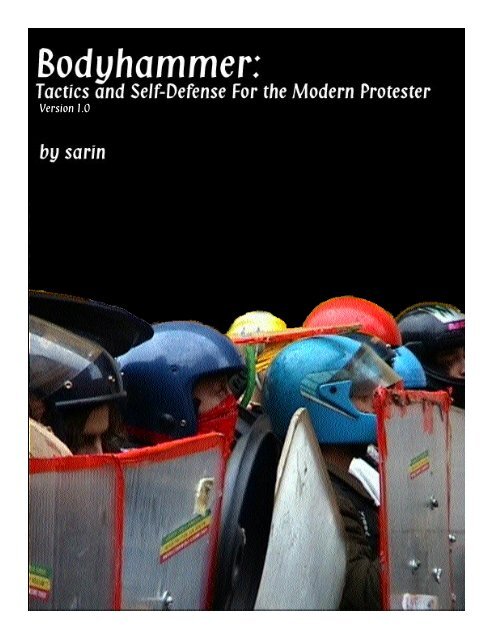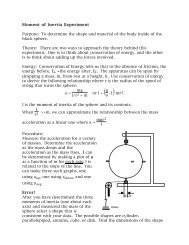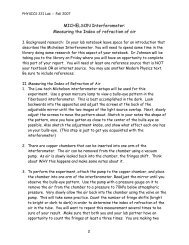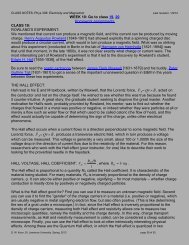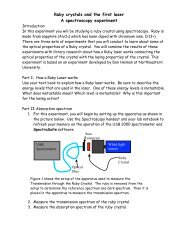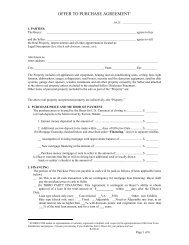Bodyhammer: Tactics & Self-Defense - Information Technology
Bodyhammer: Tactics & Self-Defense - Information Technology
Bodyhammer: Tactics & Self-Defense - Information Technology
- No tags were found...
You also want an ePaper? Increase the reach of your titles
YUMPU automatically turns print PDFs into web optimized ePapers that Google loves.
Part IShield varieties and constructionThe type of shield you are looking to use depends on the main factors of speed of construction,concealment, the actions you will be involved in and materials on hand.Selecting a shield typeAs persons who perform self-defense presumably without the use of a weapon, there are awide array of options in shield tactics. For our purposes, we are interested in forming ashield wall formation providing for freedom of movement and defense. This means that youcan choose between using a shield with the traditional one-arm method, or a two-handedmethod. While a one-armed shield provides more maneuverability, two-armed shields givegreater strength in defending oneself and pushing away the attacker. As a person is otherwiseunarmed, the two-handed shield should be considered a strong choice and critical tothe center of any shield wall. The methods of both will be described below.The other issue is the type of shield design. While much of this is based on costs andavailable materials, there are other factors to keep in mind.Transportation: If your action requires the crossing of a border bring materials for shieldsthat can double as everyday items. A large cardboard box (filled with old books perhaps) inthe back seat or a few non-inflated inner-tubes for your river-rafting trip will be easy to slipby authorities.Concealment: Taking the shield in transit from where you are staying to the action's convergencespot could find you some trouble. Large shields of course are harder to conceal.The advantage of inflatable shields is that they can be constructed while actually at the convergencespot pretty quickly.Movement: If you are expecting to have to run some and fear that there wont be enoughmembers of a shield wall to provide walking protection, larger scutum (tower) shields can bevery difficult to run with. While being held in position your knees may hit the bottom of theshield and otherwise its rather bulky.Type of action: Hopefully you will have a sense for what type of direct action is being plannedin general as well as what means of force the police plan on using. Larger shields are betterfor protecting against projectile weapons, while smaller ones are more maneuverable fordefending against truncheons. Never underestimate what the police will do, but if you knowthat their force is not equipped with rubber bullets or the like, you can presume that handto hand fighting is more likely. Also, if the type of action requires defending a perimeter,larger shields are better if nothing else for their imposing appearance.Shield shapes and advantagesA note: The simpler, DIY method presumes that shields will be made more flat, while traditionally,all shields were rounded to better deflect blows and cover the body. Roundedshields are considerably more difficult to construct with most materials. Also, for our purposeshere, shields with hard an not rounded corners are generally more adaptable, so considersquaring out a shape (e.g. the basic curved round shield becomes a flat "square"
use your body weight to press forward.Your defensive stance will be similar to the one-armed method in that you position oneleg ahead of the other, crouch slightly and brace yourself. The arms should be firm, butbend so that you can absorb part of the blow without having something break. Also, if yourshield is large enough, you can counter act by crouching further behind and surging forwardwith a jump. This should be powerful enough to keep your opponent well at bay.
Garbage can/barrel shields:The easiest shield to makeis often one that is mostly premadefor you. Found stre e titems can often work wonderfullymaking construction quickand easy. Plastic garbage cansare the easiest with lids turninginto instant shields and the cansthemselves requiring little morethan being cut in half. Orangeconstruction barrels are a littlebit more difficult to obtain, butcan similarly be used – howeverthey tend to be much moreProtesters crouch behind garbage can shields in Quebec City, April 20, 2001.rounded and hence difficult togrip in a one-armed style.Construction:With a can lid, you should be all set. That is unless you don’t want the awkward touse handle, which is not optimal for protecting yourself or advancing, but will do fine if youaren’t particular. If you desire a better grip, follow the above instructions. Furthermore,keep in mind that the handle is on the opposite side of what you might prefer. It should beattached so that the concave rounded side is what points outward.Ideal for tower shields, the body portion of a plastic trash can be used for two or threeshields depending on the size of the can and the desired width. Larger, industrial trash containersor barrels tend to be taller and will cover more area. With a saw, remove the bottomof the can and any handles on the side. Then cut the can into the desired portions. Size itup against your own body to find the desired width. Since the can is rounded, applying onearmedhandles on the inside of the shield will be a little bit trickier. While it works fine inthat manner, trashcan shields are also perfect for the two-handed grip style. If you areusing it in this manner and plan on being in the front line of a Tortoise formation, considerusing a hot knife to cut a small slit a few inches from the top to peer through.Inflatable shields:Quick to construct, easy to transport, inconspicuous and adding an extra bounce, inflatableshields are a very clever variant. On the opposite extreme of an imposing shield wall,using inflatable shields gives the disarming appearance that the police are busting up abeach party.There are two main variants of inflatable shields - rounded lifesaver style and the tall,flat pool raft. The lifesaver style is basically a round shield with some added thickness,
whereas the pool raft can provide full body protection, although they tend not to be verythick.Given what you will find, there are two variantsof the lifesaver style. The slightly smallerand lightweight option is to purchase a small,inflatable personal pool flotation device. Theseare made from plastic and are easier to punctureplus have thinner walls, but are much easier towield. Doubling up of two of these light tubes isalso an option. The heavy and strong choice arel a rge inner-tubes, often used for sitting in.These are thick, bouncy but quite heavy. Giventheir weight, they make considerably betterInnertube shields on the move in Cancun, Mexico.options as a two-handed shield, providing forstrong shoving action.The pool raft variant provides for a sort oftower shield, quite possibly one that is larger than your own body. If available, purchaserafts of the smallest variety, although due to their lightweight, an overly tall raft should notbe too obtrusive. Because such cheap pool rafts are rather thin and not very rigid, it is recommendedthat you try to affix two of them together. Thicker, heavier and much sturdierrafts also exist for about four times the cost of a cheap one.Construction:Inflatable shields have the enormous advantage of being quick to construct just beforea demonstration kicks off. With hard effort, it should take no more than 30 minutes to constructany of the variants in any style. Remember that while uninflated rafts are easy toexplain to inquisitive officers, some of the other materials needed might not be.Option 1: The first option simply requires an awful lot of tape. Packaging tape or ducttape will work just fine. They key here is to strengthen the center area of the shield withtape so that it can sustain blows without puncturing. Of course this is especially criticalwith lifesaver rafts that have an open center. Second of all, the tape is then used to fashionhandles. This is where you decide if your shield will be a one- or two-handed variety. Followthe patterns for determining handle position and angle as universally described above. Thetape is wrapped around and given slack in these areas and the slack portion is wadded soas to provide a thin grip. Make several passes to ensure strength. For raft shields thatwould require excessive amounts of tape when wrapped vertically, make the handles fromsmall strips, place them in position and then secure them down at the top and bottom ofthe handles by wrapping tape horizontally.Option 2: Option two utilizes some sort of thick plastic wrap such as a tarp, or failingthat, a strong bedsheet or other large fabric. The intention here is to substitute the massiveamounts of tape in option one with a basic covering that can sustain blows while maintainingthe bounce effect of the rafts. Either a small section of the tarp or fabric can be cutout to cover the needed area, or a much larger amount can be used to wrap the entire shield.Then use strong tape to tightly secure the material and make sure it is taut enough to maintainthe bounce factor. Be aware that packaging tape does not stick well to fabrics and thatduct tape should be used in this case. Finally, fashion handles in the same manner as inoption one.
A simple design for a super lightweight and quick to make shield that is to use soft foam,such as the kind found in chairs and soundproof padding as a core. You should be able tofind a fairly large sized block, which can then be cut to size with a knife or scissors. If thefoam is less than two inches in thickness, consider doubling it up. You will also want a pieceof card or tack-board for the front. This sort of shield looks very non-offensive and is quitecushy if possible bodily harm is a concern to you.Construction:Once you have the size of the core correct, duct tape your board surface to the front.You will have to punch holes through the entirety to position your handle. The best optionfor that is rope or any sort of firm strap. Other than that, there is very little to this design.Plexiglass shieldsPlexiglass is a highly versitile material since it can be cut and manipulated, and is fairlylightweight. Home improvement stores sell plexiglass in a variety of sizes. One could cutanything from a small one-armed shield, to a massive multi-person shield wall. The onlydraw back is the lack of flexibility means that not only are rounded shapes near impossible,but that the material can snap easily. In order to sustain baton or projectile blows the shieldwould have to be at least a 1/2” in thickness. If the material does not come that way, it canbe layered and glued with a mixed epoxy, super glue or glue gun.Construction:Plexiglass can be roughly cut with ahand-saw, but a band saw is much preferred.If you lack an electric saw, considerdrilling multiple holes in a line andsnapping off the excess. Hopefully youcan acquire the size you want right awaythough.A good idea for added reinforcement,especially if your shield is extremely large,is to affix planks of wood along the oblongsides. A full frame of wood will help thatmuch more. Just remember that woodadds a great deal more weight. Wood canTwo giant plexiglass shields envelop police in Italy, March 17, 2001. be affixed either by strong wood glue, ormore easily, screws or bolts.For the handles, remember that plexiglass is a hard surface and you will wantpadding under the place where your arm will go. Leather straps or ropes can be easilyaffixed by tying them through holes made with a drill. Again, wood helps to add stability onthe points where your handles connect to the plexiglass.
Hard foam core shield:One of the more difficult to make but longest lasting and versatile construction methodsis to use firm foam core boards, possibly wrapped with fiberglass. These can be madeto any desired size and thickness. Plus, the foam core is easy to carve, allowing you to shaperounded edges into it.Construction:Foam core is most easily obtained as blue insulation foam boards that are sold cheaplyat hardware stores in thicknesses usually under an inch. Purchase enough to allow fordouble or triple layers. Make sure the plastic covering it comes with is removed too. Afteryou cut the shape, be it circular, tower or the like, use a glue or liquid cement to sandwichlayers together.If you wish to make your shield more durable and not subject to cracking in half uponfirst impact, consider epoxying an added layer of fiberglass cloth to the front. Most glueswon’t stick well to foam core and fiberglass, so a mixed epoxy is necessary. This is obtainableat any hardware or home goods store, usually as auto or boat repair kits. Make sureyou know the sizes needed ahead of time. This should be cut after you have shaped androunded your foam core. Then epoxy along the edges and center and attach one to bothfront and back. You can trim extra cloth after all has dried.At this point your handles can be attached. You will probably need a drill, or acorkscrew to dig out a firm hole. This style should be thick enough to accommodate firmmetal handles with screws and wing nuts as well as simple ropes. Remember that since thisis a firm shield, you will want protection for your knuckles or a groove in the shield whereyour knuckles would be placed.Improvised backpack shield:In a pinch, simply placing a flat piece of plywood, layered cardboard or tagboard in an otherwiseempty backpack can make a small sized two-handed shield. The idea is to maximizethe surface area, which should garner you something approximating 15" x 12" given anaverage backpack size. You will have to remember to cut the board(s) down to a size thatfits before the day of action.The added advantage of this is its complete concealability. Apart from the rough corners,it would be hard to judge what your backpack is truly going to be used for to an outsideobserver. The downsides are pretty clear though. Not only is the shield of small size,the straps are too large to be very practical to use in a one-handed manner. One way toremedy this is to use a piece of soft rope or another non-chaffing material and wrap yourforearm in place on the backpack strap. Otherwise, use the backpack in a two-handed manner.Other shield concepts:All in all, most anything can easily become a shield so long as you adapt it to your liking.There are some materials you would wish to avoid, such as wood due to its weight. Alsometal, specifically lightweight aluminum seems like an immediate choice, it is expensive,very difficult to work with and can be painful to the bearer should it wind up jabbed back
into your face.Yet anything you think that will be lightweight, firm and easy to affix handles to will workfine. An old thumbtack board or plastic tabletop you might find in the trash would do fine.Tip: Is your found-object shield too small? A garbage can tower shield might not fullyextend down your legs - a choice place for police to fire and bouce projectiles at. A smallone or two foot extention of plexiglass can be screwed into the bottom of your shield. Tomake sure that the plexiglass doesn’t snap at first impact, consider bolting pieces of 2x2wood down the sides for added durability.Shield construction is all just a matter of the time you are willing to put in it, or dumb luckas per what you might find.Other EquipmentHelmets:Helmets are a critical part of any defensive tactic, be it a shield wall or a simple and opendirect action where attack is a major risk. As police forces have regularly demonstrated thatthey do not follow their own guidelines of avoiding blows to the head, a helmet is an importantpiece of protection.Unfortunately a helmet is too tricky a piece of equipment to make appropriately, that youwill have to acquire something pre-made.The most basic helmet with the minimal amount of protection is a construction hat.These can usually most simply be found in a toy store, provided they are large enough.Wadded newspaper inside will help soften blows. The next easiest helmets to acquire arebike or motorcycle ones. Thrift stores should have a selection of these, but otherwise theyare a little expensive.The ultimate option, although quite conspicuous in transporting are military helmets.Modern helmets are made fromKevlar meant to stop a bullet.These are extremely costly andnot necessary. What can beacquired quite cheaply are surplussteel helmets, often of foreignmake, that are sold in militarysurplus catalogs. Do aweb search for military surplusor militaria, or otherwise ask alocal army surplus store forcatalogs.For personal protection asolid helmet is probably themost important thing one canbring to a demonstration after Helmets, cadboard and life-jackets make up the body armor in this Italian march.a gas mask.
Improvised body armor:For body armor, we are basically just talking about padding and forms of wearing it.Homemade chain mail is nice, but too costly and time consuming to construct for the averageprotester. There are two basic variants of body protection that can be employed, or thereis the more complicated segmented armor described later.The first is simply added layers of clothing. A few pairs of long underwear, sweat suitsor an extra heavy coat can go a long way to soften a blow. The main draw back here is theimpeded movement at the joints and the fact that you will be sweating like a pig for most ofthe time.Other items can be improvised that are not normally worn. For example, life preservervests work wonderfully as a strong padding over your chest and back. Football and othersports padding is obviously another option.Basic body armor:The next step in body armor is affixed padding. The best material for this is foampadding, which should be available at hobby stores, or at a place that sells packing materials.Even densely rolled newspapers or clothes can work.If you have enough material, a make shift suit can be made simply by wrapping portionsand taping them together with duct tape. Otherwise the best option is to cover yourmost exposed and vulnerable parts. These would be your arms, chest and back. After that,cover your legs and stomach area. If you lack a helmet though, the first thing you shoulddo is tape a few pieces to your head, provided you value your skull more than the fear oflooking like an idiot. If you are using a large shield and feel pretty secure, consider stillpadding your upper back side and arms for they can still be struck if you are attacked fromthe sides.To keep the padding better in place, consider affixing it to an undershirt, then wearinganother piece of clothing over that. Additionally, scour thrift stores for used sports pads.Cheap shin pads can usually fit high up on your arms, and other items such as foam splintswork as improvised armor as well.Lorica Segmentata:Keeping in step with our reversion to ancient technologies we can find a cheap meansof making segmented body armor. The segmentation means that you don't have to be adeptin shaping parts or even being very careful, for you can attach new parts as needed. Thisalso allows for a degree of versatility to only cover certain body parts that you may think arecritical.Lorica Segmentata, which basically means a hardened and segmented sheath for thebody, is simplest to construct using hard and thick, but cheap and still malleable plastic.A good source for plastic that is pre-shaped with a curvature are pickle buckets, like thekind that can be taken from the dumpster of a McDonald's.First of all, prioritize the type of armor you think you'll need. As a shield bearer, youwill probably want protection for your upper shield arm(s). Following that, covering for yourother arm and then both shoulders is important. From there the chest and backside areshould follow given the amount of material you have.
Understand your target and your positionThe police are much easier to predict than most people fear. Too often, the paranoiaof being surrounded occurs in situations where the police are fairly static in their positions.Is your target a building that the police are surrounding in full force? Have they left thestreets outside of that perimiter free to protesters or do they have roving columns ready tostrike? Have you completed your objective of blockading a conference and the police are tryingto break through your formations? Are you just having a spontaneous street party anddon’t know when, if or where the police will show?Answers to these questions seem simple and obvious, yet too often mobile protestersdo not have a clear picture of what the situation is like and communication has broken downtoo much. Issues like this are what drove armies to have set heirarchies thousands of yearsago, and in the framework of avioding set leadership, communication is our only answer.Before the day of action, you should already know what to expect. Also pay attentionto what the police are intending to do or what extent they want to go to. Is it a city that hassworn off using projectiles? Is the event you are demonstrating at, such as an outdoorswearing-in ceremony, a place where thepolice are afraid to use tear gas? Have previouspolice actions demonstrated theirintention to make sweeping arrests or dothey only pick off stragglers?While its critical to always be on your toesand never trust the police to operate in acertain way, there are always warningsigns you can look for. If an empty busappears, then you can expect sweeparrests. If a squad of bike police disappearedin another direction, they are probablyout to outflank you.Conversely, always be ready to exploit yourown successes. Too often pro t e s t e r s ,unready for a success or a hasty policeretreat will merely remain in place and notseize their gains. Sticking your neck tooPolice in Philadelphia split up protesters, August 1, 2000.far out can be dangerous, but thats whenits crutial to have the protection of the masses following up behind.Movement in a shield wallFor typical movement when not immediately in a confrontational position, you shouldstill be at the ready. Traditionally defensively aware marchers have linked arms to preventindividuals from being nabbed. While carrying a shield in a wall formation, the threat ofthis is probably much less. But if necessary, persons using one-armed shields can use their
free arm to grasp the shield arm of the adjacent person. This becomes problematic with different-handedpeople however. Furthermore, this tactic should not be employed when in aconfrontation so as to allow freedom of movement for the shields.The critical aspect to moving in any shield wall formation is unison. While demonstratorswould discourage any individual to marshal a march, a form of organization is necessary.Unless it is possible to prepare and practice these tactics ahead of time, the best wayis the use of simple commands that can be shouted (examples below), including warningsof what is ahead for those who cannot see.For keeping tight in a march at any pace, the best method is a drum near the front (adrummer in the back won’t know what is going on well enough) or the calling off of steps("1, 2, 1, 2...). Given that most marching routes will be pre-determined, directions shouldnot be a major factor - apart from the tendency to lose formation when making turns.Should the shield wall be freely roaming or have loosely laid plans, calling out for slow turnsis important ahead of time, especially since intersections are where a shield wall or anymarch is most vulnerable to ambush.ScoutingA system of scouts is critical to effectively moving a shield wall, especially when it isunknown where confrontation is to be expected. This does not necessitate a series of outpostnecessarily, although that would be useful as well. What a mobile shield wall needs iseyes, which should be on at least all four corners of the march. Bicyclists or possible regular-lookingpedestrian scouts can cover their own angle of view and operate half of a blockto a full block ahead watching their respective side. Communications should be kept withone or more people in the shield wall - presumably in the second row - who are known byothers to be in touch with the scouts so that they will be given some priority in emergencysituations.Proper scouting afield can also relay information concerning vehicular movements, suchas extra police units arriving in APC's, cars or vans. Another good warning sign is emptybuses used for detaining large numbers of protesters.If there are multiple targeted locations where the march is trying to head (such as tryingto breech the perimeter preventing access to a public area), scouts are crucial as toinforming which location would be best given shifts in the police strengths.BarriersMetal inter-locked barriers arethe typical means of blockadingmarches by the police. When ashield wall approaches a barrier itmust be opened or knocked downprior to penetration by the wall. Ifpolice protection of the barrier isminimal, people in the back rowsshould be called ahead to removethe barriers so that the shield walldoes not lose its cohesion in the act. Protesters appropriate metal barriers in Cincinnati on November 16, 2000.
If police are present behind the barrier and safe from an advance, the shield wall shouldadvance close enough so that people reaching from within the wall can pull it down. If thepolice resist the movement of a barrier, persons in the shield wall should try to advance sothat their shields extend over the barriers protecting hands that are pulling it down andknocking away those of the police.Splitting formationsThe tendency for demonstrators to seek safety in numbers sometimes precludes wise tacticaldecisions. When safety is just as guaranteed with your march split in two, than itwould be almost foolish not to split into two shield-wall covered marches that keep in contact.Simply put, a shield wall of 1000 people rushing a barricade on a street that is 60 feetwide will probably leave some 800 people standing around not helping because of a lack ofspace. Your odds improve the more the police are thinned and caught by surprise.The most effective thing a shield wall can do is confuse authorities as to the intent of themarch. To that end having one or more factions split up and take different routes will throwa police operation into disarray. Because the police are restricted to following ranking officersand their commands (at least while maneuvering) if your march splits while the shadowingpolice force only has one officer among itself, it cannot break in two to follow bothgroups.A shield wall should consider the possibility of splitting up tactically only when there areenough shields. This can be judged knowing if forming a testudo later on might be critical,but if not, than only a few rows of shields and the perimeter and rear groups are needed. Amass of 1000 shields isn't going to be any more effective as a shield wall than 500. Keep inmind if you might end up in an open space like a square or a park where the potential widthof your wall may have to grow or your density of shield might be important to defend againstflank attacks.Knowing when to split up also depends on the local situation, but is definitely most effectivewhen trying to breech a perimeter that has multiple entry points. The police work on asystem of reserves, sending more officers to points that may be or are in trouble. So if twobarricades are rushed simultaneously, the chances of one or both succeeding is significantlyhigher.The main question is then, when can you split? A good rule of thumb for safety with amarch is that there are enough people to cover slightly more than one city block. This isnecessary to prevent being boxed in from two intersections at once. If numbers are doublethis, than splitting up is not only feasible but a very smart move. Also, keep in mind thatthe odds of getting boxed in a trap are greatly lessened when there are, say, three marcheswalking along different streets as the police have far more repositioning to do and are probablyspread too thin if they didn't expect your move. Multiple shield walls roaming a cityalso provide far better coverage for affinity groups that may wish to perform more dangerousoperations.RetreatSo should a situation come to this and the possibility of arrest or extreme cautionbecomes necessary, it might be time to beat a retreat.Historically, retreating armies suffer the worst losses. The same is true in demon-
strations when people break and run in fear. While there is no real practical means ofteaching people to avoid this panic, a few cool heads can save the day. The first criticalthing a person can do in this situation is to yell "Don't run!" as the first fear should bestampeding other people - a horrible and demoralizing possibility.The shield wall then in the frontline must act to play rear guard, which can be doneby walking backwards at a good pace. If needed, a one-armed shield holder can brace himor herself by gabbing the arm o the person next to them. Calling out with "Hold the line!"may also help in keeping cohesion.This should also provide physical and visual coverage for those who may havetaken "illegal" actions and are a target for police forces. It also will provide grounds forthose that find it critical to use projectiles to stem the police onslaught.This type of situation is the most difficult to maintain cohesion during, but arguablythe most important. If individual police officers are allowed into protester lines, they willbegin arresting and beating those particulars. A shield wall that is maintained can savescores - but always remain wary of being boxed in at such times.A scout in the rear can be used to determine which direction the retreat should takeas well as to observe when it is safe to stop.
Setting up your formationsThe only way to guarantee maximum effectiveness of the variety of shields and bodyarmor employed is that every affinity group uses similar equipment as much as possible.Since rows are set up of one or more affinity groups marching together and it is in no one'sinterest to break up affinity groups, it would be foolish to have some people in your grouparrive with massive shields, and others with just a helmet.Once converging, everyone participating in shield wall formations can agree amongeach group as to who goes where. Groups with inner tube or tower shields will be urged tobe near the front or at least highly exposed. Remember this isn’t a demonstration of heroics- it is a matter of practicality as to which affinity groups are in the front because they arehelping to defend the entire march. By visual consensus it should not be hard to determinewho should position themselves where, unless certain groups do not feel comfortablenear the front. Remember that DIY equipment is made to be disposable, and swappingequipment might be an important function of solidarity even if you labored for hours on yourparticular shield.FormationsWedge ChargeThis method, requiring much coordinationis derived from a classic Viking method of charging.It requires a good deal of discipline, not tomention an awful lot of courage on the part of theperson in front. This method also requires thespace to make for a near running charge to providemaximum disarray and psychological intimidationagainst opponents.A wedge will have one or two persons infront, using the two-handed method with aslarge a shield as possible. The two lines that followto the right and left of the focal point slightlyangle their shields to the outside direction.Once in position a countdown to a charge shouldbe given and the charge should be made at a A classic v-shaped viking wedge formation.quick pace of short steps to keep tight, as full sprinting will lose cohesion.The wedge works by focusing on one point and pressing upon it while the two angledsides deflect forces attempting to aid the one point and widening the breech. It also keepsa degree of cohesion for those attempting to break through. A normal flat line of attack mayopen a hole in one or two places, but they are difficult to expand upon and to even noticefor reinforcements to converge upon.Another advantage of the wedge is that if a person in the lead is about to be nabbed,
there is immediate support behind him or her to pull them back away from arrest. It isthen critical to remain close to the person in front of you. A wedge need not be more than7-11 persons across or about 4 persons deep. Extra bodies can be used to fill the inside ofthe wedge, and form a solid line behind it - although at the ready to push through thebreech.Pulse chargeThis is another method that takes discipline, and planning ahead of time. It probablyis too complicated to be considered, but it’s included for the concept anyhow. The pulse, asthe name implies is a series of quick and short engagements that are just as quickly brokenoff. This should work to throw the police off balance and catch them by surprise when thereal push is made. If pre-arranged, such that 3 pulses will occur before the real press, thensimple shouting commands will work.The difficulty is being able to disengage - as people behind you may not be aware ofyour methods. A possible effective manner is to use only one line of shields, having a fewpeople behind to ask the rest of the crowd to wait until the final real charge. Otherwise,this is probably a move too difficult to coordinate.The Echelon ChargeSimilar in effect to the wedge, but easier to set up, the echelon also works in a defensivemanner. It is set up such that a given wing of the shield wall is extended ahead, slopingdown to the other side of the wing, like the shape of a guillotine blade. Each personstands slightly behind and to the side of the person in front.The principle behind this tactic is to turn the flank of a cordon of police and executea breakthrough there. Traditionally, this is done on the right wing of the shield wall, turningthe left wing of the police formation and for the sake of preparation, it is a good idea tokeep this as a standard - unless the police have caught on of course. To add to the effectof pressing one corner of the opposing line, the weight of added bodies should be added tothis side.In effect, the one edge pushes through on one corner, turning the flank while the otherend of the echelon advances enough to keep those police at bay. Hence the weight pushesthrough one side and the other wing of the police is helpless to cometo their aid. This method not only breaks the police line, it also boxesthem in to a degree, forcing a very disorganized withdraw on theirpoint. The confusion should be enough to deter the police from pressingyour weakened left wing.Alternately, if an echelon is too difficult to form, a simple straightline with added weight to one side can have a similar effect.Tortoise or TestudoA simple tortoise formation.The tortoise formation is the essence of the shield wall. Now whiletypical advancements may only require a front row of shields, the tortoiseformation aims to protect both the front and the top from rainingprojectiles such as tear gas canisters. A tight wall above and in the
front can also protect against direct spray items such as pepper spray nozzles and watercannons.Traditional tortoise formation dictates that the first row of shields lay theirs at groundlevel while the second row reaches over the shoulders of the first at an angle to double thefront protection while then the third and subsequent rows protect the top. Additionallymembers on the side would protect the flanks if necessary.As the tortoise was employed for protectionagainst arrows and javelins in antiquity, it is only crucialtoday in situations of situations where police projectilesare thrown. As it is naturally a slow movingformation, it is not recommended for actions indefense against batons for the loss in visibility in findinggaps among the police lines.For the purposes here, a formation with onefront row of shields and the remainder providing ceilingsupport should suffice. As moving fast invariabledevelops cracks in the formation, move to a slowrhythm or the chant of "1, 2, 1, 2..." A tactical objectiveof the Tortoise is to get close enough to policerounds to render projectile weapons ineffective. Thiswill relieve protestors in the rear of the need for flight.Immediately once contact is made with the policelines, the tortoise should break into supportive rowsof frontal shields aimed at defending each otheragainst baton blows.Riot police advancing in a tortoise formation.SquareThis defensive tactic, or a loose derivative of it should be employed when you have asingle position to defend against imminent attack, and your numbers are rather small. Thiscan arise typically when trying to block the path of vehicles in a spontaneous move.The traditional square was a formation the British Imperial armies would use todefend from massed cavalry attacks. For our purposes, it works to prevent or at least prolongarrest even when surrounded or when injecting yourselves into a compromisable position.The square is simply set to face around a point with your shields out. As you areimmobile, kneeling will provide a smaller space for the police to try to crack. In reality, youwill probably end up with more of a circular formation than an actual square, but the ideais the same. And if you happen to find a stockpile of muskets, what the hell, have a go atit.Extreme self-defense tacticsWhen facing an opposing force that is hell bent on breaking laws and violatingyour rights by viciously attacking you, any code of self-defense allows for extreme measures.By this we mean to include the throwing of projectiles and use of bludgeon weapons
which serve to distract and disorientate the opposition so that the demonstrators mightregroup or escape.While injury to others is never a facet to embrace in self-defense, we must recognizethis possibility as it has happened in the past, and will probably occur again. If thepolice are prepared for the worst, so should we. While this is not the place for a moraltreatise, the general philosophy is that we are fighting for life and freedom, and so longas we don’t fight for death and oppression as our enemies do, we have moral fortitude onour side.Grease guns, smoke and paint bombs and other items don’t necessarily injure andalso can provide tactical advantages in disorientating the police.But, as this is a booklet concerning self-defense tactics, we won’t get into specifics onmore aggressive street fighting manners. And hey, how much do you need to know aboutthrowing a brick?This booklet is in a rough form and will be updated with more diagrams, constructionimages and concepts as time goes on.Contact the author with ideas, field testing, more images and criticisms at sarin@devo.comMy thanks to all of those that have contributed thus far.


